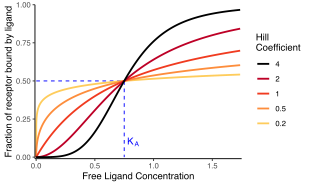
In biochemistry and pharmacology, the Hill equation refers to two closely related equations that reflect the binding of ligands to macromolecules, as a function of the ligand concentration. A ligand is "a substance that forms a complex with a biomolecule to serve a biological purpose" (ligand definition), and a macromolecule is a very large molecule, such as a protein, with a complex structure of components (macromolecule definition). Protein-ligand binding typically changes the structure of the target protein, thereby changing its function in a cell.
The distinction between the two Hill equations is whether they measure occupancy or response. The Hill equation reflects the occupancy of macromolecules: the fraction that is saturated or bound by the ligand.[1][2][nb 1] This equation is formally equivalent to the Langmuir isotherm.[3] Conversely, the Hill equation proper reflects the cellular or tissue response to the ligand: the physiological output of the system, such as muscle contraction.
The Hill equation was originally formulated by Archibald Hill in 1910 to describe the sigmoidal O2 binding curve of haemoglobin.[4]
The binding of a ligand to a macromolecule is often enhanced if there are already other ligands present on the same macromolecule (this is known as cooperative binding). The Hill equation is useful for determining the degree of cooperativity of the ligand(s) binding to the enzyme or receptor. The Hill coefficient provides a way to quantify the degree of interaction between ligand binding sites.[5]
The Hill equation (for response) is important in the construction of dose-response curves.
- ^ Neubig, Richard R. (2003). "International Union of Pharmacology Committee on Receptor Nomenclature and Drug Classification. XXXVIII. Update on Terms and Symbols in Quantitative Pharmacology" (PDF). Pharmacological Reviews. 55 (4): 597–606. doi:10.1124/pr.55.4.4. PMID 14657418. S2CID 1729572.
- ^ Gesztelyi, Rudolf; Zsuga, Judit; Kemeny-Beke, Adam; Varga, Balazs; Juhasz, Bela; Tosaki, Arpad (31 March 2012). "The Hill equation and the origin of quantitative pharmacology". Archive for History of Exact Sciences. 66 (4): 427–438. doi:10.1007/s00407-012-0098-5. ISSN 0003-9519. S2CID 122929930.
- ^ Langmuir, Irving (1918). "The adsorption of gases on plane surfaces of glass, mica and platinum". Journal of the American Chemical Society. 40 (9): 1361–1403. doi:10.1021/ja02242a004.
- ^ Hill, A. V. (1910-01-22). "The possible effects of the aggregation of the molecules of haemoglobin on its dissociation curves". J. Physiol. 40 (Suppl): iv–vii. doi:10.1113/jphysiol.1910.sp001386. S2CID 222195613.
- ^ Weiss, J. N. (1 September 1997). "The Hill equation revisited: uses and misuses". The FASEB Journal. 11 (11): 835–841. doi:10.1096/fasebj.11.11.9285481. ISSN 0892-6638. PMID 9285481. S2CID 827335.
Cite error: There are <ref group=nb> tags on this page, but the references will not show without a {{reflist|group=nb}} template (see the help page).